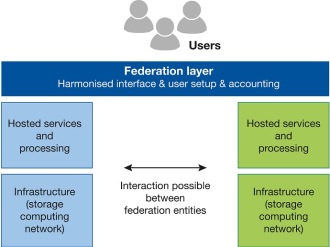

The European Weather Cloud, a distributed cloud computing infrastructure of ECMWF and EUMETSAT providing access to data and other services from the two organisations, becomes operational on 26 September 2023.
The aim of the European Weather Cloud is to provide a hub for the meteorological community in ECMWF and EUMETSAT Member and Co-operating States, so that users from different countries and organisations can be brought together to collaborate and share resources.
The European Weather Cloud allows users to customise and deploy their applications and workflows, as well as build and expose services through the web. Users run applications and services next to where the data is produced, avoiding large data movements over the network.
Main benefits
By creating the European Weather Cloud as a joint project, ECMWF and EUMETSAT enable direct access to and processing of both organisations’ data holdings. Future federation with other relevant cloud infrastructures in our Member and Co-operating States may further widen the range of accessible data.
The basic idea is to bring users to the data instead of transferring vast amounts of data to users. This is becoming even more important as ECMWF moves towards higher-resolution global ensemble forecasts.
Bringing together data holdings from across the entire European Meteorological Infrastructure (EMI) in a single federated cloud infrastructure makes it possible to access and process multiple datasets, separately or in combination.
Federation capability
A key characteristic of the European Weather Cloud is that it has a federation capability. This makes it possible for an entity of the EMI, such as an ECMWF Member or Co-operating State or a group of such states, to be connected to the European Weather Cloud via the federation interface.

The European Weather Cloud will be a federation of different entities held together by a federation layer. Users can interact with the different entities in a harmonised and consistent way.
The data holdings or hosted services of this entity would then become discoverable and accessible for use within the rest of the European Weather Cloud. All users from this entity as well as from others would be able to integrate the new services and data available as part of their applications and workflows.
More information
Various use cases of the European Weather Cloud have been demonstrated, for example to generate a set of satellite images accessible by a range of countries, and as a collaboration platform on which training courses can be run. Information on who can access it is available on the web page of the European Weather Cloud.
